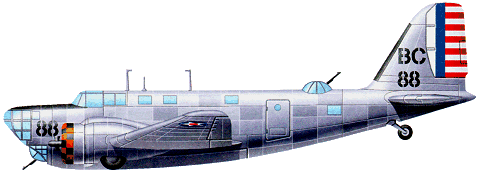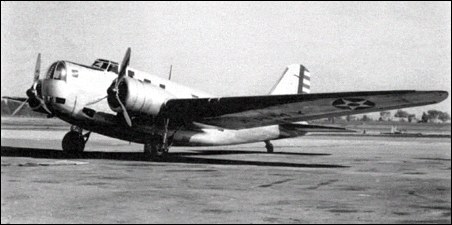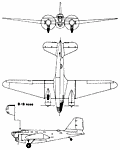 |
Douglas B-18 Bolo1935 |  |
| BOMBER | Virtual Aircraft Museum / USA / Douglas |
 |
Faced with a US Army Air Corps requirement of early 1934 for a bomber with virtually double the bomb load and range capability of the Martin B-10, which was then the USAAC's standard bomber, Douglas had little doubt that it could draw upon engineering experience and design technology of the DC-2 commercial transport which was then on the point of making its first flight. Private-venture prototypes to meet the US Army's requirements were evaluated at Wright Field, Ohio, in August 1935, these including the Boeing Model 299, Douglas DB-1 and Martin 146. The first was built as the B-17 Flying Fortress, the last was produced as an export variant of the Martin B-10/B-12 series, and the Douglas DB-1 (Douglas Bomber 1) was ordered in January 1936 into immediate production under the designation B-18. Derived from the commercial DC-2, the DB-1 prototype retained a basically similar wing, tail unit and powerplant. There were, however, two differences in the wing: while retaining the same basic planform as the DC-2, that of the DB-1 had a 1.37m increase in span and was mounted in a mid-wing instead of low-wing position on an entirely new fuselage, one that was deeper than that of the commercial transport to provide adequate accommodation for a crew of six, and to include nose and dorsal turrets, a bomb-aimer's position, and an internal bomb bay. There was, in addition, a third gunner's position, with a ventral gun discharging via a tunnel in the underfuselage structure. Powerplant comprised two 694kW Wright R-1820-45 Cyclone 9 engines. A total of 133 B-18s was covered by the first contract, this number including the single DB-1 which had served as a prototype. True production aircraft, which had the type name Bold, had a number of equipment changes, producing an increase in the normal loaded weight, and more-powerful Wright R-1820-45 radials. The last B-18 to come off the production line differed by having a power-operated nose turret, and carried the company identification DB-2, but this feature did not become standard on subsequent production aircraft.
 The next contracts, covering 217 B-18 A aircraft, were placed in June 1937 (177) and mid-1938 (40). This version differed by having the bomb-aimer's position extended forward and over the nose-gunner's station, and the installation of yet-more-powerful Wright R-1820-53 engines. Most of the USAAC's bomber squadrons were equipped with B-18s or B-18As in 1940, and the majority of the 33 B-18As which equipped the USAAC's 5th and 11th Bomb Groups, based on Hawaiian airfields, were destroyed when the Japanese launched their attack on Pearl Harbor. When in 1942 B-18s were replaced in first-line service by B-17s, some 122 B-18As were equipped with search radar and magnetic anomaly detection (MAD) equipment for deployment in the Caribbean on anti-submarine patrols under the designation B-18B. The Royal Canadian Air Force also acquired 20 B-18As which, under the designation Digby Mk I, were employed on maritime patrol. The designation B-18C applied to two other aircraft reconfigured for ASW patrol. Another two aircraft were converted for use in a transport role under the designation C-58, but many others were used similarly without conversion or redesignation. Douglas B-18 Bolo on YOUTUBE
|  COMPANY PROFILE | ||||||||||||||||||||||||||||||||||||||||||||||||||||||||||||||||
 |

|



Hello Chris!
My name is Kent Thompson. I am someone who is always on the hunt to explore and visit interesting places. I've recently come across your B18 bomber in Hawaii. I was wondering if it would be possible for me to visit the plane crash site and make a documentary type video about it. I guess what I'm asking is if I could have permission to visit your property. I respect people's private property and wouldn't want to cause any trouble. Anyway, I hope this is a good way to get ahold of you. You are the only person I've been able to find who might have some insights for me. Feel free to look at some of my videos. I never give out locations, vandalize, or disrespect anything. I simply like to make informative, anonymous videos. youtube.com /wherekentwent Thanks and I hope to hear back from you!
reply